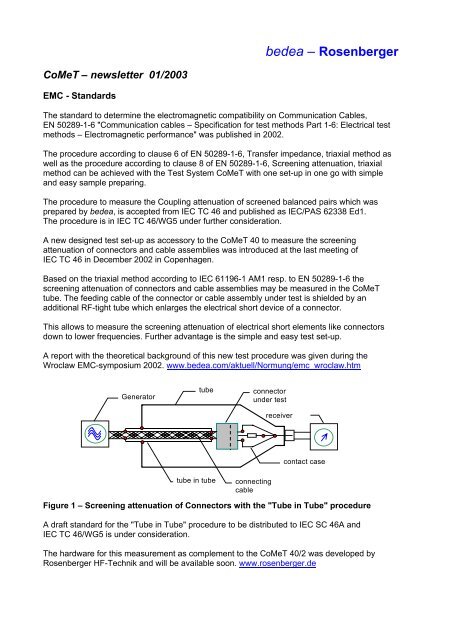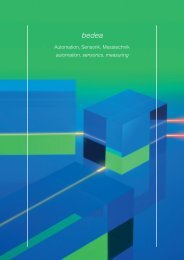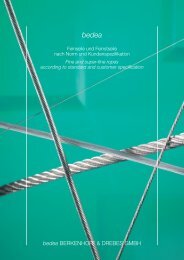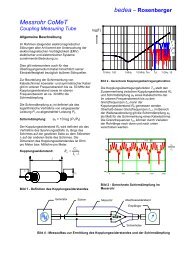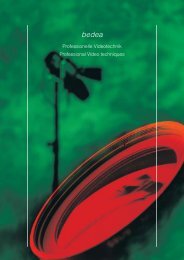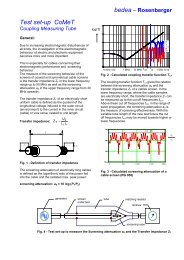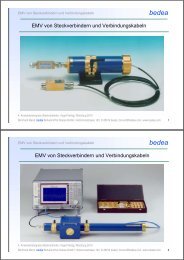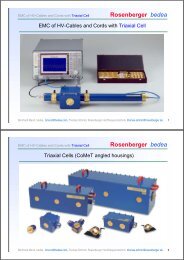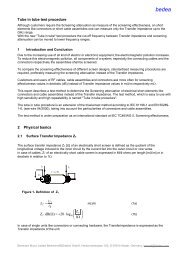bedea â Rosenberger - Bedea Berkenhoff & Drebes GmbH
bedea â Rosenberger - Bedea Berkenhoff & Drebes GmbH
bedea â Rosenberger - Bedea Berkenhoff & Drebes GmbH
Create successful ePaper yourself
Turn your PDF publications into a flip-book with our unique Google optimized e-Paper software.
edea – <strong>Rosenberger</strong><br />
CoMeT – newsletter 01/2003<br />
EMC - Standards<br />
The standard to determine the electromagnetic compatibility on Communication Cables,<br />
EN 50289-1-6 "Communication cables – Specification for test methods Part 1-6: Electrical test<br />
methods – Electromagnetic performance" was published in 2002.<br />
The procedure according to clause 6 of EN 50289-1-6, Transfer impedance, triaxial method as<br />
well as the procedure according to clause 8 of EN 50289-1-6, Screening attenuation, triaxial<br />
method can be achieved with the Test System CoMeT with one set-up in one go with simple<br />
and easy sample preparing.<br />
The procedure to measure the Coupling attenuation of screened balanced pairs which was<br />
prepared by <strong>bedea</strong>, is accepted from IEC TC 46 and published as IEC/PAS 62338 Ed1.<br />
The procedure is in IEC TC 46/WG5 under further consideration.<br />
A new designed test set-up as accessory to the CoMeT 40 to measure the screening<br />
attenuation of connectors and cable assemblies was introduced at the last meeting of<br />
IEC TC 46 in December 2002 in Copenhagen.<br />
Based on the triaxial method according to IEC 61196-1 AM1 resp. to EN 50289-1-6 the<br />
screening attenuation of connectors and cable assemblies may be measured in the CoMeT<br />
tube. The feeding cable of the connector or cable assembly under test is shielded by an<br />
additional RF-tight tube which enlarges the electrical short device of a connector.<br />
This allows to measure the screening attenuation of electrical short elements like connectors<br />
down to lower frequencies. Further advantage is the simple and easy test set-up.<br />
A report with the theoretical background of this new test procedure was given during the<br />
Wroclaw EMC-symposium 2002. www.<strong>bedea</strong>.com/aktuell/Normung/emc_wroclaw.htm<br />
Generator<br />
tube<br />
connector<br />
under test<br />
receiver<br />
contact case<br />
tube in tube<br />
connecting<br />
cable<br />
Figure 1 – Screening attenuation of Connectors with the "Tube in Tube" procedure<br />
A draft standard for the "Tube in Tube" procedure to be distributed to IEC SC 46A and<br />
IEC TC 46/WG5 is under consideration.<br />
The hardware for this measurement as complement to the CoMeT 40/2 was developed by<br />
<strong>Rosenberger</strong> HF-Technik and will be available soon. www.rosenberger.de
New developments and accessories for the CoMeT test set-up<br />
<strong>bedea</strong> – <strong>Rosenberger</strong><br />
CoMeT- newsletter - 01/2003 - S. 2<br />
There are different improvements, complements and accessories to the CoMeT test set-up<br />
about which we want to inform you more detailed.<br />
Due to the modular construction, the different components or complements may be assembled<br />
without any restriction.<br />
1 Stretching device<br />
When measuring the screening attenuation in the tube, the cable under test shall be centred in<br />
the middle of the tube to avoid changes of the characteristic impedance in the second system.<br />
This may be achieved by maintain the measurement with vertical mounted tube but with<br />
incumber handling<br />
With the stretching device, one can keep the sample centred in the horizontal mounted tube.<br />
Care should be taken not to apply to high stretching forces to the screen of the sample because<br />
this will change its characteristics.<br />
The stretching device is equipped with a torque wrench which allows to control the stretching<br />
force.<br />
Figure 2 – Stretching device for the CoMeT test set-up<br />
Supply schedule: Stretching device, 1 set of contact slices, 2,2 to 9,8 mm, torque wrench<br />
An investigation of the influence of stretching forces to the test results of screening<br />
measurements may be ordered from <strong>bedea</strong>.<br />
2 Extension set for 10mm to 15mm diameter<br />
Measuring the screening attenuation and the transfer impedance up to 15mm diameter over<br />
screen with the CoMeT 40/2 (standard application up to 9,8mm over screen).<br />
The additional reflection due to the enlarged case shall be taken into account when evaluating<br />
the test results.<br />
An investigation of the influence of additional reflections to the test results of screening<br />
measurements may be ordered from <strong>bedea</strong>.<br />
Supply schedule: Enlarged contact case, contact slices from 9,8mm to 14,8 mm.<br />
<strong>bedea</strong> <strong>Berkenhoff</strong>&<strong>Drebes</strong> <strong>GmbH</strong>, Postfach 1140, D-35607 Asslar, Germany, bmund@<strong>bedea</strong>.com
edea – <strong>Rosenberger</strong><br />
CoMeT- newsletter - 01/2003 - S. 3<br />
3 Complement set "high screening"<br />
When measuring screening attenuation of > 85 dB, special care shall be taken to contact the<br />
screen of the sample under test in the connecting case. If the contact slices don't fit close to the<br />
screen under test or if a open slot remains in the connecting case, wrong test results may be<br />
obtained.<br />
The complement set "high screening" consists of a separated case which presses the contact<br />
slices close to the screen when screwing it together. Due to the smaller gradation of the contact<br />
slices the fitting to the screen is improved.<br />
Measurements with the complement set "high screening" with a semi rigid cable sample<br />
resulted in ≥ 135 dB screening attenuation up to 1 GHz and ≥ 125 dB up to 3 GHz.<br />
sheath<br />
contact slice<br />
inner conductor<br />
thread<br />
braidt<br />
screening case<br />
contacting resistor<br />
and braid<br />
load resistance<br />
Figure 3 – Contact case of the Complement set "high screening"<br />
Supply schedule: 1 set contact slices with intermediate sizes of 2,55mm to9,55 mm, separated<br />
contact case with pressing device, brass, golden and VA-steel.<br />
4 Additional contact cases<br />
To measure the screening attenuation of connectors and cable assemblies, the connecting case<br />
was modified that one can connect the assembly or the connector direct to the contact case.<br />
The mating part of the connector under test can be mounted direct to the contact case and<br />
matched with its characteristic impedance. Figure 4 shows an example wit a F-connector.<br />
For the measuring of cables with connectors respectively of cable assemblies different cases<br />
with drillings for different connector systems are available, e.g. F-connector, (CATV, 75 Ohm) N-<br />
50-system, BNC etc.<br />
Furthermore, a contact case with feeding hole for other connector systems or threads is<br />
available.<br />
With the same principle also IEC- and BNC-connectors may be applied.<br />
The different contact cases may be used also with the new "Tube in Tube" system.<br />
<strong>bedea</strong> <strong>Berkenhoff</strong>&<strong>Drebes</strong> <strong>GmbH</strong>, Postfach 1140, D-35607 Asslar, Germany, bmund@<strong>bedea</strong>.com
edea – <strong>Rosenberger</strong><br />
CoMeT- newsletter - 01/2003 - S. 4<br />
F-Connector F-feed through thread<br />
sheath<br />
braid<br />
inner conductor<br />
load resistance<br />
screening cap<br />
Figure 4 – Contact case for connectors.<br />
Furthermore an enlarged contact case (10mm) is available to take in matching resistors,<br />
e.g. the printed boards MKS 2 +2 resp. MKS 8 + 2. to match balanced data cables.<br />
5 Angled head<br />
Measuring the screening attenuation and the transfer impedance of cable assemblies with<br />
angled connectors. Suitable for different connector systems, e.g. those of clause 4.<br />
Figure 5 – Angled head<br />
The angled head may be combined also with the new "Tube in Tube" system.<br />
Suitable for the CoMeT 40/2.<br />
<strong>bedea</strong> <strong>Berkenhoff</strong>&<strong>Drebes</strong> <strong>GmbH</strong>, Postfach 1140, D-35607 Asslar, Germany, bmund@<strong>bedea</strong>.com
edea – <strong>Rosenberger</strong><br />
CoMeT- newsletter - 01/2003 - S. 5<br />
6 Open test head<br />
Measuring the Coupling attenuation of screened balanced cables.<br />
The procedure to measure the Coupling attenuation with the open head is international<br />
standardised as IEC/PAS 62338 Ed1, Coupling attenuation, triaxial method.<br />
Figure 6 – Open test head<br />
7 Contact case for RJ 45 connectors<br />
Measuring the Screening attenuation and the Coupling attenuation of balanced cable<br />
assemblies, e.g. of Patch cables.<br />
Figure 7 – Connecting case for RJ 45 connector<br />
The matching resistors of the different pairs are already integrated. The mating part of the<br />
RJ 45 connector inside the case may be changed easily.<br />
<strong>bedea</strong> <strong>Berkenhoff</strong>&<strong>Drebes</strong> <strong>GmbH</strong>, Postfach 1140, D-35607 Asslar, Germany, bmund@<strong>bedea</strong>.com
8 Printed board MKS 2+2/8+2<br />
<strong>bedea</strong> – <strong>Rosenberger</strong><br />
CoMeT- newsletter - 01/2003 - S. 6<br />
To measure Transfer impedance, Screening attenuation and the Coupling attenuation, the<br />
sample under test shall be matched with its characteristic impedance inside the matching case.<br />
In case of coaxial cable this is done easily with a Mini-Melf or comparable resistor, which is<br />
soldered between inner- and outer conductor. This task is much more difficult in case of<br />
balanced cables with four or more pairs.<br />
To match balanced pairs, the printed board contains two parallel mounted 50 Ohm mini<br />
resistors with one 25 Ohm mini resistor in series. This allows to match the common mode as<br />
well as the differential mode. The printed board is designed to fit into the contact case.<br />
Supply schedule: 100 Boards each.<br />
9 Control software for Windows®<br />
The new Software is a complete rework of the former DOS-Version.<br />
The new Control- and evaluation Software WinCoMeT is completely new designed for<br />
MS-Windows ® NT/Windows ® 2000 respectively Windows ® XP.<br />
<strong>bedea</strong> <strong>Berkenhoff</strong>&<strong>Drebes</strong> <strong>GmbH</strong>, Postfach 1140, D-35607 Asslar, Germany, bmund@<strong>bedea</strong>.com
edea – <strong>Rosenberger</strong><br />
CoMeT- newsletter - 01/2003 - S. 7<br />
The basic version of the WinCoMeT software includes the measurements of Transfer<br />
impedance, Screening attenuation and Transmission.<br />
With pull down commands different types of networkanalyzers may be chosen and controlled.<br />
With the storage procedure test results may be stored and prepared for further evaluation.<br />
Beside multiple possibilities of the graphic representation, test results may be send to<br />
MS-Excel ® or to MathCad ® by mouse click.<br />
(for now as ß-version available)<br />
Prices for all components on request.<br />
Production of all components:<br />
<strong>Rosenberger</strong> Hochfrequenztechnik <strong>GmbH</strong> & Co.<br />
Postfach 1260<br />
D - 84526 Tittmoning<br />
www.rosenberger.de<br />
Sales and Service:<br />
<strong>bedea</strong> <strong>Berkenhoff</strong> & <strong>Drebes</strong> <strong>GmbH</strong>, Asslar<br />
Contact and further information's:<br />
Bernhard Mund<br />
<strong>bedea</strong> <strong>Berkenhoff</strong> & <strong>Drebes</strong> <strong>GmbH</strong><br />
Herbornerstraße 100<br />
D - 35614 Asslar<br />
Germany<br />
Tel.: +49 6441 801 133<br />
Fax.: +49 6441 98 32 30<br />
e-mail: bmund@<strong>bedea</strong>.com<br />
homepage: www.<strong>bedea</strong>.com<br />
<strong>bedea</strong> <strong>Berkenhoff</strong>&<strong>Drebes</strong> <strong>GmbH</strong>, Postfach 1140, D-35607 Asslar, Germany, bmund@<strong>bedea</strong>.com


